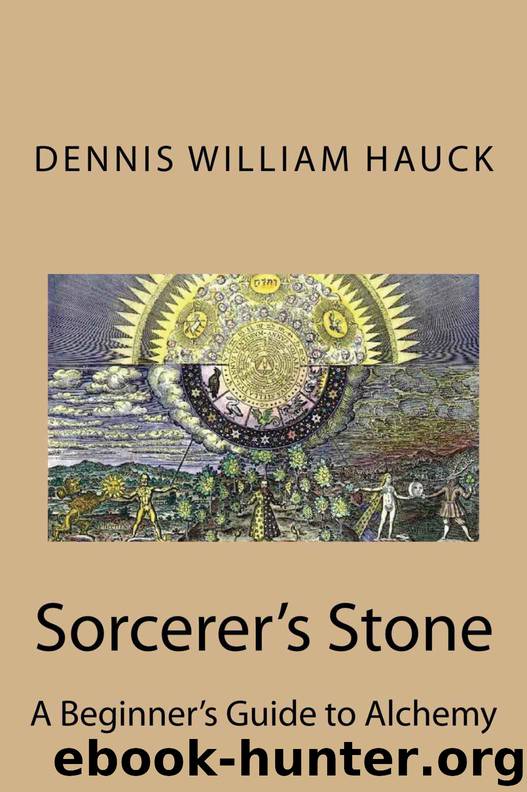Sorcerer's Stone: A Beginner's Guide to Alchemy by Dennis William Hauck

Author:Dennis William Hauck [Hauck, Dennis William]
Language: eng
Format: azw3
Publisher: 978-1481179140
Published: 2017-07-31T04:00:00+00:00
Chapter 8: Mar’s Challenge
The Angry Metal Iron
Iron is the second oldest metal known to man (after lead) and was known in prehistoric times. Genesis says that Tubal-Cain, seven generations from Adam, was "an instructor of every artificer in brass and iron." Iron was smelted by the Egyptians at least as far back as 1500 BC and iron artifacts from Asia have been identified from around 3000 BC. A remarkable wrought iron pillar nearly 25 feet high, dating to about 400 AD, remains standing today in Delhi, India. Corrosion to the pillar has been minimal despite its exposure to the wet weather since its erection.
Our word “iron” comes from the Anglo-Saxon word "iren,” although that word is derived from earlier words meaning "holy metal," because it was used to make the swords used in the Crusades. The symbol for iron is Fe, which comes from the Latin word for iron (ferrum). The root of the Latin word means “to create, to form, to bear forth." The alchemical cipher for iron ism, which is also the symbol for the male generative force. In iron we recognize the male and active character of the war-god Mars, building and conquering in a new and sometimes hostile world. As we have only recently learned, it is the massive amounts of iron oxide on its surface that gives the planet Mars its red color, though that correspondence would hardly have surprised the ancients.
Iron is a relatively abundant element in the universe. It is found in the sun and many types of stars in considerable quantity since iron nuclei are very stable. Iron is a vital constituent of plant and animal life on, and is the key component of hemoglobin in the blood. The pure metal is not often encountered in modern commercial applications but is usually alloyed with carbon or other metals. The pure metal is very reactive chemically, and rapidly corrodes, especially in moist air or at elevated temperatures. However, as an oxide and in other ores, iron is the most abundant metal on earth, forming up to 5% of the planet’s crust.
Native iron is quite often a misnomer as natural pure iron is not necessarily "native" to earth, since it rarely occurs on the earth's surface by terrestrial processes. It is mostly found in the form of meteorites that have impacted the earth's surface. All natural iron, whether it is native or meteoritic, is actually an alloy of iron and nickel. The two elements are combined in varying percentages from less than 6% nickel to as much as 75% nickel, although iron is by far more common than nickel. Iron is steel gray or black with a metallic luster, is somewhat malleable and strongly attracted to magnets. Iron filings cause spectacular sparks in flames and react explosively in a burning mixture of potassium chlorate and sucrose.
Iron has an unusual relationship with carbon and readily combines with it to form a nobler and stronger metal known as steel. European alchemists noticed this effect when they accidentally dropped bits of charcoal into molten iron.
Download
This site does not store any files on its server. We only index and link to content provided by other sites. Please contact the content providers to delete copyright contents if any and email us, we'll remove relevant links or contents immediately.
The Power of Now: A Guide to Spiritual Enlightenment by Eckhart Tolle(5534)
The Miracle Morning by Hal Elrod(4495)
Rising Strong by Brene Brown(4340)
Being Aware of Being Aware by Rupert Spira(3166)
The Secrets to Charisma and Personal Magnetism: Learn a hidden energy tradition to become magnetically attractive and vitally alive by Martins Bruno(2630)
The Lost Art of Good Conversation by Sakyong Mipham(2497)
The Songlines by Bruce Chatwin(2470)
The Gifts of Imperfection by Brene Brown(2466)
A New Earth: Awakening to Your Life's Purpose by Eckhart Tolle(2443)
The Power Of Now by Eckhart Tolle(2148)
All Things New by John Eldredge(2074)
The Nature of Consciousness by Rupert Spira(2009)
The Untethered Soul: The Journey Beyond Yourself by Singer Michael A(1994)
The Empath's Survival Guide by Judith Orloff(1977)
Thoughts Without A Thinker: Psychotherapy from a Buddhist Perspective by Epstein Mark(1937)
The Seat of the Soul by Gary Zukav(1905)
Practicing the Power of Now by Tolle Eckhart(1830)
The Yoga of Jesus: Understanding the Hidden Teachings of the Gospels by Paramahansa Yogananda(1776)
Be Feel Think Do by Anne Berube(1751)
